-
Car Reviews
- All reviews
- Midsize SUVs
- Small cars
- Utes
- Small SUVs
- Large SUVs
- Large cars
- Sports SUVs
- Sports cars
- Vans
Latest reviews
- Car News
-
Car Comparisons
Latest comparisons
- Chasing Deals
With bold new exterior looks and a stunning new interior, does the new Pathfinder offer enough to overcome its aging underpinnings?
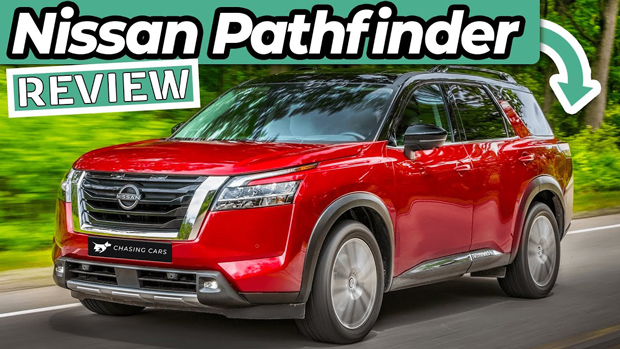
Once a household name in Australia, the Nissan Pathfinder was a staple in the ‘soft-roader’ segment, coming up against vehicles such as the Toyota Kluger and Kia Sorento.
After a recent hiatus from Australia, the Pathfinder is back, wearing a far more American aesthetic that hides familiar underpinnings.
Now in its fifth generation, the Nissan Pathfinder has been pulled inline with Nissan’s new SUV design language, as evident in the Juke small SUV.
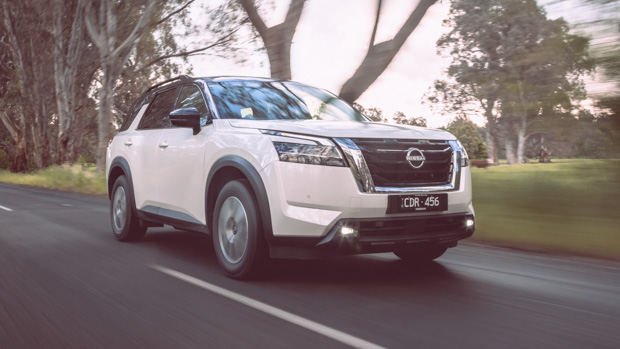
At the front, the revised look consists of a large “v-motion” grille that sits between the large LED headlights. The Pathfinder also gets Nissan’s “floating roof” design for the first time, which makes use of a two-tone paint scheme.
At the back, the Pathfinder is undoubtedly of American origin, with large Pathfinder lettering across the tailgate and slim tail lights.
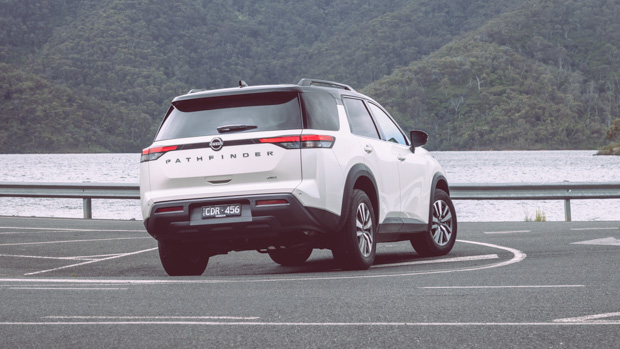
All together, Nissan Australia is confident that this new styling conveys a sense of “strength and capability” while also reducing front overhang.
In Australia, the Pathfinder range starts with the ST at $58,915 driveaway, and runs through to the range-topping Ti-L at $86,822 driveaway. During the local launch of the SUV, we focused on the mid-range Ti model, which starts from $71,225 driveaway and is offered in either 4×2 or 4×4 form.
Starting at $58,915 driveaway, the ST is the entry to the Pathfinder range, and is exclusively offered in front-wheel drive form. Just like the rest of the range, it makes use of a 3.5-litre V6 petrol engine that’s paired with a nine-speed automatic transmission.
Standard kit is reasonably generous on the tech front at this level, with the ST getting a 9.0-inch infotainment system with satellite navigation as well as wireless Apple CarPlay and Android Auto. It also gets a 7.0-inch digital cluster, and a 10.8-inch head-up display.
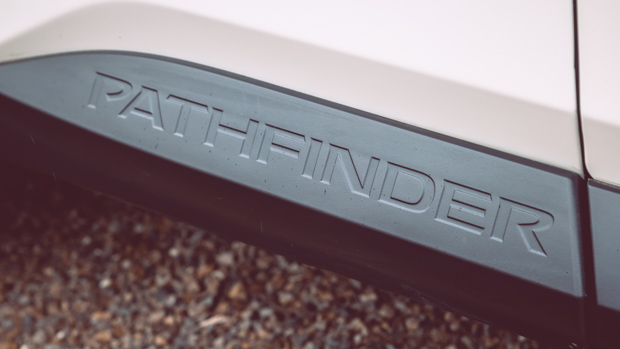
Tri-zone climate control is standard on the ST, and it gets vents in the second and third rows of seating. Cloth covers the eight seats that are offered in the ST, an arrangement made up of two in the front, three in the second row, and three in the third row.
The next step up in the Pathfinder range is the ST-L, which is offered exclusively in 4×4 form, and starts from $66,895 driveaway. Standard kit on the inside of the Pathfinder is largely the same between the ST and the ST-L, with the addition of a leather accented steering wheel.
Other goodies that are added in the ST-L include remote engine start via the key fob, a power tailgate, and tinted windows behind the A-pillar.
Sitting above the ST-L in the Pathfinder range is the Ti, which starts from $71,225 and is the only model that gives buyers the choice between a two-wheel drive and a four-wheel drive powertrain.

The biggest change on the inside from the ST-L is the leather-accented upholstery that covers the first and second rows of seating. Heated second row seating is added here, as are rear door sun shades and an automatically dimming rear view mirror.
Sitting at the top of the Pathfinder range is the Ti-L, which costs $86,822 driveaway. It’s most distinguishable from the lower spec variants via its seven-seat configuration with a pair of captain chairs in the second row.
It’s also the only Pathfinder to get a larger 12.3-inch digital display and the premium Bose sound system. Quilted leather covers the seats in the first and second row, and it gets the same synthetic leather in the third row as the Ti.
As mentioned, the kit beneath the bold new exterior of this fifth-generation Pathfinder feels quite familiar, and that’s mostly down to the engine.
Powered by a naturally-aspirated 3.5-litre petrol V6 making 202kW of power and 340Nm of torque, this Pathfinder has the tendency to feel dated in a modern world where forced induction is prevalent.
Despite sharing the same engine as the last-generation model, the Pathfinder’s nine-speed automatic transmission is a new unit, and a far better choice than the CVT that it replaced.
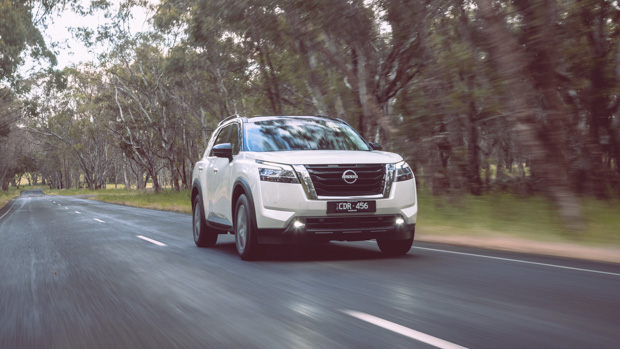
Though this powerplant might feel dated, its biggest downfalls are also positive aspects in some ways, as not many family-friendly SUVs have (reasonably) big displacement engines anymore.
As you’d expect, torque is plentiful across the rev range, and with so many ratios on hand, the transmission wastes no time in finding the engine’s power band when the pedal is planted.
In terms of performance, Nissan hasn’t provided a 0-100km/h figure, but the Pathfinder doesn’t waste time for an SUV of its stature, so I’d estimate it’s around the eight-second mark.
Though plentiful with power and torque, this large engine loses points in my eyes in the refinement category, as it’s loud and cumbersome under load.
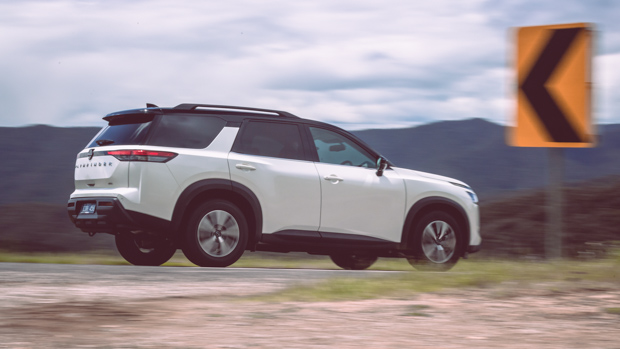
This is something that most owners will likely get used to, but it’s a bit of a letdown when it comes to an SUV that looks as modern as this one does.
Unlike other automatic transmissions with a plethora of gears (more than six qualifies in my eyes) this Nissan unit doesn’t seem to confuse itself when sprung into action.
In more family-friendly driving scenarios, the transmission is extremely smooth when shifting, and leaves the engine at a comfortably low rpm when cruising at 110km/h.
Ride quality is one area where this new Pathfinder excels, as the water-damaged Victorian roads where the local launch was held never once broke its composure.
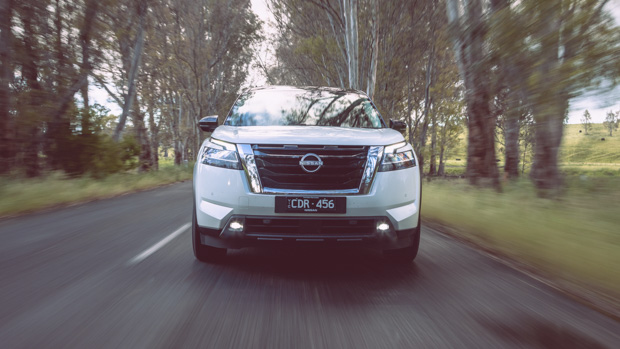
The Pathfinder Ti 4×4 comes with seven different drive modes (five in the 4×2), but without adaptive dampers, I was skeptical as to what the differences between modes would be.
It turns out my suspicions were correct in the fact that the ride doesn’t change between modes, but that isn’t a problem as the ride is very impressive.
The biggest differences between the road-friendly driving modes (Normal, Eco, and Sport) seem to be related to the throttle response and the transmission calibration.
In Eco, the throttle response is damped, and the transmission will shift earlier to conserve fuel. Sport mode counters both these elements to maximise performance. Meanwhile, Normal sits perfectly in the middle.
During the launch, Nissan Australia gave us the opportunity to tow jet skis on trailers during the drive route. Though these jet skis were nowhere near the 2.7-tonne braked capacity of the Pathfinder, they were probably bordering on the unbraked capacity of 750kg.
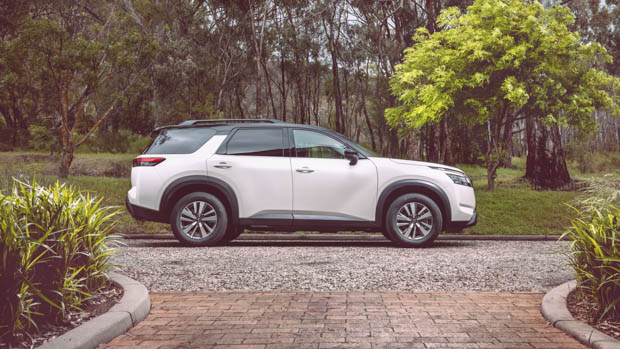
If anything, having some weight behind the SUV only improved its already impressive ride, and although acceleration was slightly hampered, the Pathfinder was extremely proficient whilst towing.
Steering is impressive in the Pathfinder, but road feel is almost non-existent. That said, the electric power steering system has a reasonable weight to it and the ratio is reasonably quick.
Considering the sheer size of the Pathfinder, it’s of little surprise that the traction levels aren’t communicated through the steering wheel and this vague feeling doesn’t inspire much confidence.
As a whole, I found the Pathfinder to be a nice drive during the local launch. Refinement in the engine compartment is a little lacking, but this can be excused for the age of the engine, and is made up for with reasonable handling, and an excellent ride.
On the inside, the Pathfinder’s interior not only looks fantastic, but it’s great to use and has a very premium feeling about it.
Though it doesn’t get the same quilted leather upholstery as the range-topping Ti-L variant, the leather accented seats are still very nice.
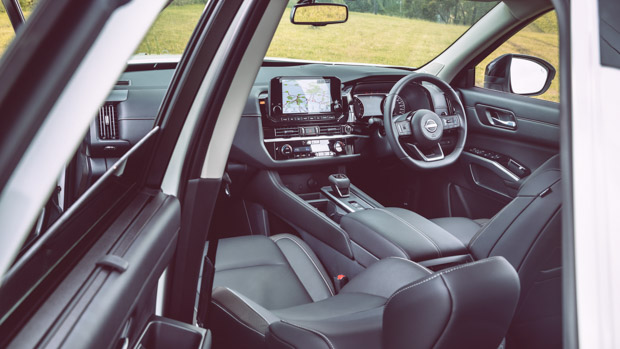
Elsewhere, soft-touch materials cover almost every surface across the cabin, which is contrasted in the front row by a little bit of piano black. The Pathfinder also comes as standard with a perforated leather steering wheel, which adds to the premium feeling.
In terms of cabin technology, the Pathfinder Ti gets a 7.0-inch digital cluster that’s paired with a 10.8-inch head up display. Though both displays are reasonably basic, driving information is clear and the faux-analogue gauges are charming.
Sitting in the centre of the Pathfinder’s dash is a 9.0-inch infotainment display with built-in navigation and wireless Apple CarPlay. Android Auto is also supported with this system, but only via a connecting cable.
As standard, Nissan’s operating system is great to use, and the built-in navigation system is surprisingly intuitive. The Pathfinder Ti also gets a premium Bose sound system as standard.
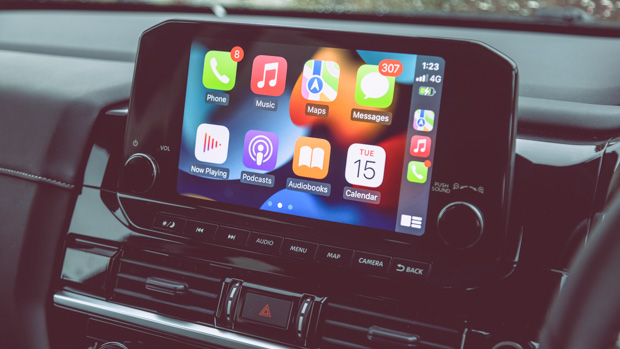
A powered adjustment driver’s seat is standard across the range, but opting for any model beneath the Ti-L will land buyers with a manual passenger seat. This is a little disappointing considering that the Ti is, at $75,550, bordering on luxury car pricing.
Moving to the second row, amenities are generous with tri-zone climate control as standard, as are air vents in the third row.
Passenger space is an interesting topic with the Pathfinder, as not only are three rows of seating standard, but so are eight seats.
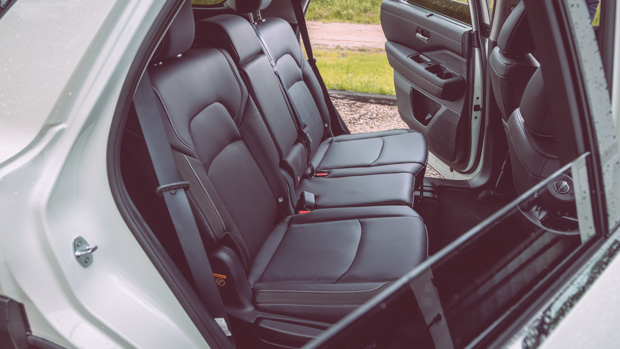
This is achieved by slotting in a third seat in the centre of the third row, not that anyone of any size will find this to be particularly comfortable. Opting for the range-topping Ti-L variant brings this down to just seven seats, with two captains chairs sitting in the second row.
Space is plentiful across the second row, and the majority of passengers will find leg and head room to be very generous.
A perfectly flat four means middle passengers won’t be left awkwardly straddling a transmission tunnel, but it’s still likely going to be a squeeze to get three adults across the second row.
As for cargo space, the Pathfinder has 205 litres with all rows of seating in place, converting to 554 litres with the third row folded and 782 with both rear rows down. Though this doesn’t sound like a lot for a large SUV, it matches the Toyota Kluger at 552 litres with just the third row stowed.
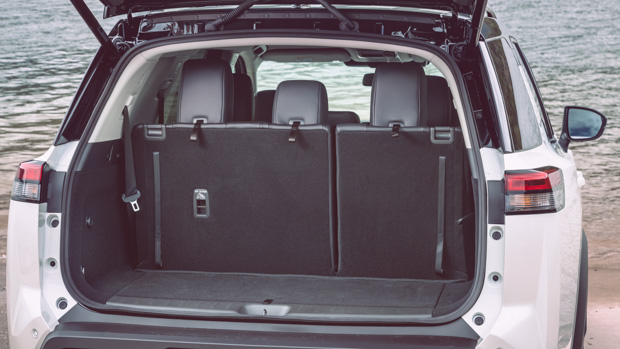
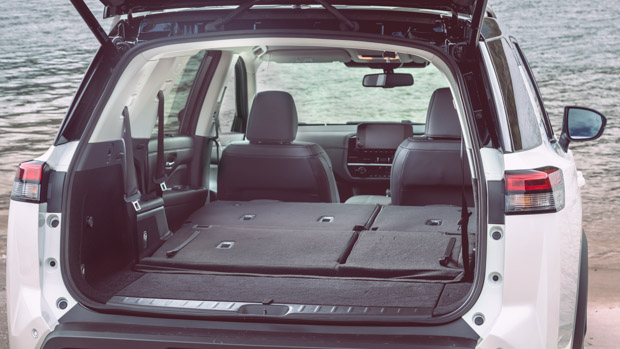
Nissan’s full Pro Pilot safety suite comes standard across the Pathfinder range. This suite covers all of the key bases for advanced active safety tech, with inclusions such as adaptive cruise control, lane-keep assist and blind spot monitoring.
During the drive on the launch, I found the speed limit assist function in the adaptive cruise control system to be particularly helpful, which identifies new limits and allows the driver to select it via the steering wheel.
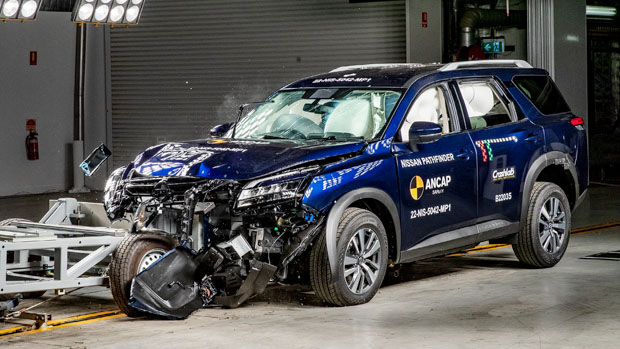
One slight issue I did have with the Pro Pilot system is keen intervention of the lane-keep assist system, which is quite forceful with its inputs. During highway driving, I didn’t find this particularly annoying, but it was one the winding back roads, that I had to turn it off.
The Nissan Pathfinder was just recently awarded a five-star ANCAP safety rating and scored well for overal child occupant protection, with a new technology such as the front-centre airbag also aiding in driver and passanger protection up front.
Nissan claims a combined fuel economy of 10.5L/100km for the 4×4 Pathfinder. That is reasonably high by modern standards and quite a bit higher than the Toyota Kluger, which is powered by a similar V6 engine and unlike its rival, the Pathfinder is not currently offered with a hybrid option.
During the launch, we managed to get 10.6L/100km, which is remarkably close to Nissan’s claim and that even included the section with a jet ski in tow. In reality, we can imagine that highway driving would lead to an even lower figure, but it’d likely still be high in comparison to its rivals.
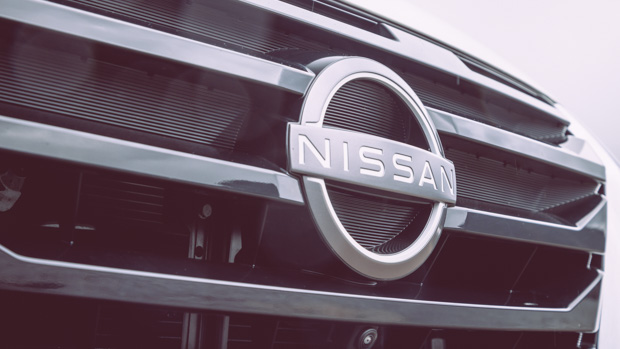
In terms of servicing, Nissan Australia offers a capped-price plan that covers the Pathfinder for up to six years or 90,000km. This costs $4206 with service intervals every 12 months or 15,000km.
When it comes to the warranty, the Pathfinder is covered under Nissan Australia’s five-year/unlimited-kilometre plan.
As a whole, Nissan’s new Pathfinder is an impressive update on a household name that Australians trust. Unlike Toyota or Kia, Nissan isn’t pushing any boundaries with this new Pathfinder and is just giving buyers what they know, which isn’t necessarily a bad thing.
As a standalone unit, the engine is great. It’s not the most refined power plant, and it drinks a fair bit, but it’ll get owners from A to B with little hassle.
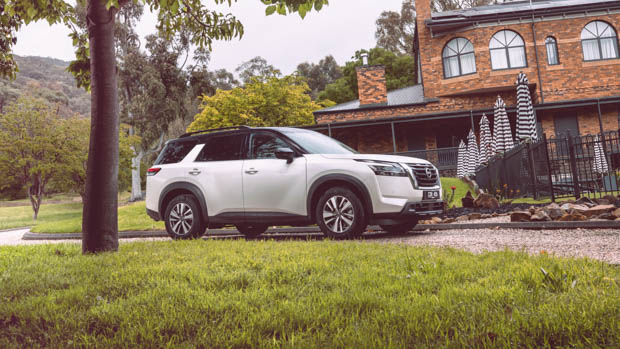
We know this because the VQ35 has already proven itself on the reliability front (over the past two decades). But in a modern world where emissions and fuel economy are front of mind for a lot of buyers, it’s a disappointment.
Besides this, the rest of the Pathfinder feels extremely well put together, and easily outdoes most of its competitors when it comes to the premium feeling of its cabin.
Space is also generous across the three rows of seating, so Australian families should have little issue fitting every member in. But again, don’t expect a comfortable trip if you have the misfortune of occupying that centre seat in the third row.
Key specs (as tested)
About Chasing cars
Chasing Cars reviews are 100% independent.
Because we are powered by Budget Direct Insurance, we don’t receive advertising or sales revenue from car manufacturers.
We’re truly independent – giving you Australia’s best car reviews.
The estimate provided does not take into account your personal circumstances but is intended to give a general indication of the cost of insurance, in order to obtain a complete quote, please visit www.budgetdirect.com.au. Estimate includes 15%^ online discount.
^Conditions Apply
Budget Direct Insurance arranged by Auto & General Services Pty Ltd ACN 003 617 909(AGS) AFSL 241 411, for and on behalf of the insurer, Auto & General Insurance Company Limited(ABN 42 111 586 353, AFSL 285 571).Because we don’t know your financial needs, we can’t advise you if this insurance will suit you. You should consider your needs and the Product Disclosure Statement before making a decision to buy insurance. Terms and conditions apply.
Indicative quote based on assumptions including postcode , 40 year old male with no offences, licence suspensions or claims in the last 5 years, a NCD Rating 1 and no younger drivers listed. White car, driven up to 10,000kms a year, unfinanced, with no modifications, factory options and/or non-standard accessories, private use only and garaged at night.
^Online Discounts Terms & Conditions
1. Discounts apply to the premium paid for a new Budget Direct Gold Comprehensive Car Insurance, Third Party Property Only or Third Party Property, Fire & Theft Insurance policy initiated online on or after 29 March 2017. Discounts do not apply to optional Roadside Assistance.
2. Discounts do not apply to any renewal offer of insurance.
3. Discounts only apply to the insurance portion of the premium. Discounts are applied before government charges, taxes, levies and fees, including instalment processing fees (as applicable). The full extent of discounts may therefore be impacted.
4. We reserve the right to change the offer without notice.